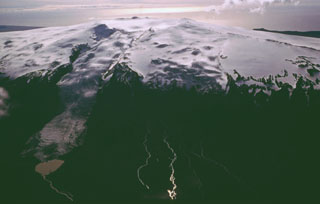Report on Eyjafjallajokull (Iceland) — 26 May-1 June 2010
Smithsonian Institution / US Geological Survey
Weekly Volcanic Activity Report, 26 May-1 June 2010
Managing Editor: Sally Sennert.
Please cite this report as:
Global Volcanism Program, 2010. Report on Eyjafjallajokull (Iceland) (Sennert, S, ed.). Weekly Volcanic Activity Report, 26 May-1 June 2010. Smithsonian Institution and US Geological Survey.
Eyjafjallajokull
Iceland
63.633°N, 19.633°W; summit elev. 1651 m
All times are local (unless otherwise noted)
The Nordic Volcanological Center (NVC) at the Institute of Earth Sciences reported that on 26 May steam plumes from Eyjafjallajökull rose to an altitude of 2 km (6,600 ft) a.s.l. and drifted S. The crater was not seen through the web cameras due to poor visibility from remobilized, blowing ash. Scientists conducted an expedition to the summit crater the next day. They measured the tephra deposits around the E half of the craters, and found that they were about 40 m thick closest to the craters. Steam rose from the crater, punctuated by a few small ash-bearing explosions, and a sulfur odor was strong nearby. On 31 May and 1 June, widespread drifting of existing ash was noted in SW Iceland. Meteorological clouds prevented views of the summit craters.
Geological Summary. Eyjafjallajökull (also known as Eyjafjöll) is located west of Katla volcano. It consists of an elongated ice-covered stratovolcano with a 2.5-km-wide summit caldera. Fissure-fed lava flows occur on both the E and W flanks, but are more prominent on the western side. Although the volcano has erupted during historical time, it has been less active than other volcanoes of Iceland's eastern volcanic zone, and relatively few Holocene lava flows are known. An intrusion beneath the S flank from July-December 1999 was accompanied by increased seismic activity. The last historical activity prior to an eruption in 2010 produced intermediate-to-silicic tephra from the central caldera during December 1821 to January 1823.
Source: Institute of Earth Sciences

